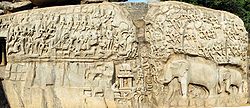- Descent of the Ganges (Mahabalipuram)
-
Descent of the Ganges - Group of Monuments at Mahabalipuram * UNESCO World Heritage Site
Country India Type Cultural Criteria (i)(ii)(iii)(vi) Reference 249 Region ** south asia Inscription history Inscription 1984 (8th Session) * Name as inscribed on World Heritage List
** Region as classified by UNESCODescent of the Ganges at Mahabalipuram, in the Tamil Nadu state India, is one of a group of monuments that were designated as a World Heritage Site since 1984.[1] Measuring 96 feet (29 m) long by 43 feet (13 m) high, it is a giant open-air relief carved of the a monolithic rock. The monuments and sanctuaries were built by the Pallava kings in the 7th and 8th centuries. The legend depicted in the relief is the story of the descent of the sacred river Ganges to earth from the heavens led by Bhagiratha. The waters of the Ganges are believed to possess supernatural powers. The descent of the Ganges and Arjuna's Penance are portrayed in stone at the Pallava heritage site.[2]
Contents
Two Interpretations
In one interpretation, a figure in the bas-relief who is standing on one leg is said to be Arjuna performing an austerity Tapas to receive a boon from Shiva as an aid in fighting the Mahabharata war. (The boon which Arjuna is said to have received was called Pasupata, Shiva's most powerful weapon).
The bas relief is situated on a rock with a cleft. Above the cleft was a collecting pool, and at one time, water may have flowed along the cleft. Figures within the cleft are said to represent Ganga or the River Ganges and Shiva. This provides the basis for an alternative interpretation of the mural. Rather than Arjuna, the figure performing austerities is said to be Bhagiratha. Bhagiratha is said to have performed austerities so that Ganga might descend to earth and wash over the ashes of his relatives, releasing them from their sins. To break Ganga's fall from heaven to earth, she falls onto Shiva's hair, and is divided into many streams by his tresses.
Figures
One of the notable, and perhaps ironic figures in the bas-relief is the figure of a cat standing on one leg (apparently as an austerity). This may be related to the Panchatantra as an ascetic in order to lure a hare and a bird to come near. (When near, he devours them.)
See also
Notes
- ^ "Group of Monuments at Mahabalipuram". http://whc.unesco.org/en/list/249/. Retrieved 2007-03-03.
- ^ "The Descent of the Ganges - Story of Bhagirata". http://www.indiantemples.com/beliefs/gangadesc.htm. Retrieved 2007-03-03.
External links
Links to related articles World Heritage Sites in India North Agra Fort · Buddhist Monuments at Sanchi · Fatehpur Sikri · Humayun's Tomb · Keoladeo National Park · Khajuraho Group of Monuments · Mountain Railways of India (Kalka-Shimla Railway)1 · Nanda Devi and Valley of Flowers National Parks · Qutub Minar and its Monuments · The Red Fort complex · Rock Shelters of Bhimbetka · Taj Mahal
Northeast East Mahabodhi Temple Complex at Bodh Gaya · Mountain Railways of India (Darjeeling Himalayan Railway)1 · Sun Temple at Konark · Sundarbans National Park
South Great Living Chola Temples at Thanjavur, Gangaikonda Cholapuram and Darasuram · Group of Monuments at Hampi · Group of Monuments at Mahabalipuram · Group of Monuments at Pattadakal · Mountain Railways of India (Nilgiri Mountain Railway)1
West Ajanta Caves · Champaner-Pavagadh Archaeological Park · Chhatrapati Shivaji Terminus · Churches and convents of Goa · Elephanta Caves · Ellora Caves · Jantar Mantar
1 Shared with other region/s Categories:- Archaeological sites in Tamil Nadu
- Mahabalipuram
- Archaeological monuments in Tamil Nadu
- Indian culture stubs
Wikimedia Foundation. 2010.



